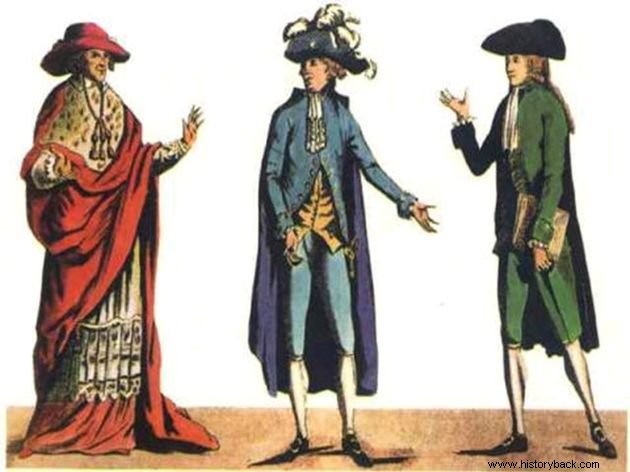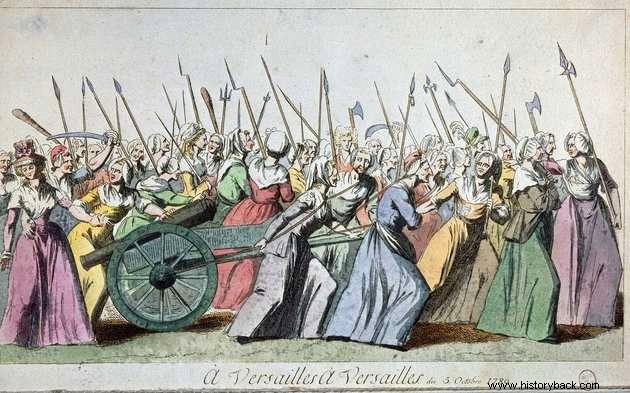Ancient Regime is the denomination of the political and social system of France before the French Revolution (1789).
During the Ancien Régime, French society was made up of different states:clergy, nobility and bourgeoisie.
On the top rung was the king, who ruled according to the Divine Right Theory in which he asserted that the sovereign's power was bestowed by God.
The term was applied after the revolution to differentiate the two types of government.
Characteristics of the Old Regime
Policy
The politics of the Ancien Régime was characterized by Absolutism.
This consisted in the concentration of political authority on the king with the support of the theory of divine right, developed by the philosopher Jean Bodin. There was an assembly that brought together the three states, but this could only be convened when the king decided.
The last king to rule France during the Ancien Régime was Louis XVI (1754 - 1793), of the Bourbon dynasty, who died on the guillotine.
Economy
During the Old Regime, mercantilism prevailed, a set of economic norms where the State organized and intervened in the economy.
According to mercantilist ideas, the wealth of a country was based on monopoly, on the accumulation of metals and on the regulation of the economy by the State.
See also:MercantilismSociety
The society of the Ancien Régime was divided into estates comprised of clergy, nobility, bourgeoisie and peasants. The clergy and nobility were exempt from taxes that fell on bourgeois and peasants.
For his part, the king ruled under the theory of divine right, centralizing the decisions of the executive, legislative and judiciary. For this, he was supported by the Catholic Church.
 See also:Estates Society
See also:Estates Society First State
The first state was represented by the clergy . France was a Catholic country and the Church was responsible for birth and death records, education, hospitals, and, of course, the religious life of the French.
The Church exercised strong influence over the government because several high clergy figures such as cardinals, bishops and archbishops were advisers to the king. However, there was the low clergy, who worked in rural areas and small towns and who had no assets.
The Church was tax-exempt and owned land and real estate. In this way, he managed to accumulate great wealth.
However, the King interfered in ecclesiastical affairs and took advantage of religious ceremonies to reassert his power as God's representative on Earth.
See also:Medieval ChurchSecond State
The second estate consisted of the nobility , people with hereditary titles and who held important positions in the government.
The nobles were landowners and lived extolling luxury. In order not to rival the king's power, they had been co-opted by the monarch to live in Versailles, at the French court.
The nobility was divided according to the seniority of their titles, as some nobles had received them at the time of the Crusades.
On the other hand, there were nobles who were former bourgeois who managed to reach this condition by having bought titles of nobility or by marrying nobles who were impoverishing.
Like the clergy, they paid no taxes and accumulated positions in the French government.
See also:AbsolutismThird State
At the base of French society were the ordinary people , the third state, which corresponded to 95% of the population. In this class were the bourgeois, rich merchants and professionals.
In this layer were also the peasants and servants of the nobles, who faced difficulties to maintain minimum conditions of survival, such as food and clothing.
The third estate was heavily taxed and it was the only state that paid taxes.
See also:BourgeoisieThe Enlightenment and the Ancien Régime
The Enlightenment was a French intellectual movement that took place between the 17th and 18th centuries and that questioned the economic, social and political model of the Middle Ages. For them, nothing good happened at this time and the Illuminists classified it as the "Dark Ages".
Supported by a new vision about God, about reason, about the nature of humanity, the Enlightenment had a significant influence on revolutionary thought.
The Enlightenment held that the goals of humanity are knowledge, freedom and happiness. Furthermore, they wanted a government where powers were divided and the role of the sovereign was limited.
See also:EnlightenmentCrisis in the Ancien Régime

From 1787, the old French political and social organization began to be questioned through Enlightenment ideas.
Also contributing to this was the financial crisis in which France plunged after the failure of the wheat harvests in the years 1787 and 1788, and the military expenditures in the War of Independence of the United States.
The failure in the countryside did not prevent the increase in tax collection to the third estate, which began to demand better social conditions and government reform.
The king convened the Estates General to find a solution to the financial crisis. However, both the first and second states did not accept to abdicate their privileges and integrate the tax collection regime.
The design of the revolution occurred with the organization of the bourgeoisie and the lower clergy, who managed to establish a constitutional monarchy.
See also:Constitutional MonarchyThe French Revolution and the end of the Ancien Régime
The French Revolution brought about the end of the Ancien Régime in France and later in Europe.
The bourgeoisie resented the exclusion of power and rejected the last vestiges of anachronistic feudalism.
For its part, the French government was on the verge of bankruptcy; the increase in population proportionately increased discontent over the lack of food and the excess of taxes.
In the ideological context, Enlightenment ideas advocated a new order and the theory of divine right was no longer accepted.
See also:French Revolution (1789)Continue to study on this subject:
- Absolute State
- Modern State
- Bourgeois Revolutions
- Questions about Enlightenment
